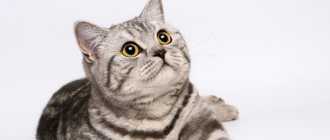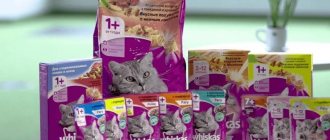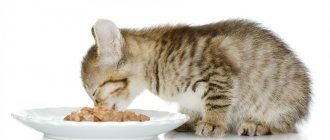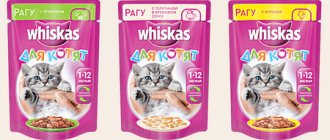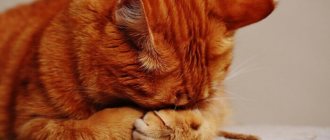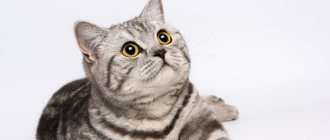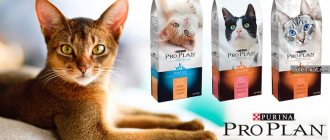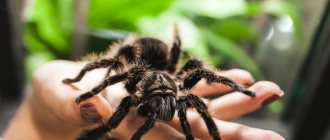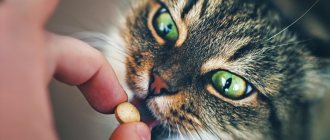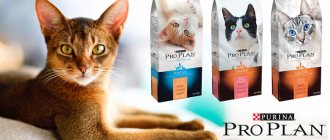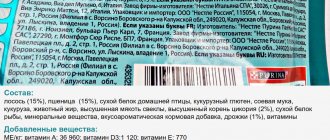The Whiskas brand is so popular that even a person who does not have a cat knows that this is cat food. This brand is more than 50 years old, and its value exceeds a billion dollars. It is one of forty-two brands owned by the largest corporation Mars, and belongs to the Petcare division, specializing in the production of products for pets. Today we will tell you about Whiskas cat food without any pretense or myths - only facts about the composition of the food, assortment, reviews about it, and so on.
Brand history
Whiskas was the first animal food product to be commercialized by the American company Mars. This happened in 1932, and now in terms of sales it is in first place among industrial diets for cats in the world. Divisions of this company are located all over the world, but the main representative office of Mars Petcare is located in Belgium, in Brussels. In 1991, the company began operating in Russia, and already in 1995, the first plant for the production of food for pets opened in Stupino. At the moment, there are already several feed production factories in the Russian Federation.
The pride of the company is the Waltham research and development center, located in the UK. Leading experts in the field of veterinary medicine and pet nutrition are developing new concepts that are used in ready-made food formulas for cats. One of the most famous achievements of this laboratory is the recognition of the important role of taurine in the body of cats.
Cats are not able to produce this substance on their own and can only get it from food, so Whiskas was the first food to which it was added. This was a significant breakthrough in the field of ready-made diets for domestic cats. Currently, all complete feeds include taurine.
Whiskas
This type of food first appeared on the market in 1958 in the UK, produced by Pedigree Petfoods Ltd. in Melton Mowbray, UK, where other well-known brands of animal food are also produced: Chappie, Kitekat, Pedigree, Royal Canin. Pedigree Petfoods has been part of the Mars Corporation since 1935, when it was called Chappel Brothers Ltd.
Creating a single brand for both European and American countries, as well as Asian countries, was a thoughtful and successful decision to conquer the international market.
In addition, Whiskas was the first cat food to offer consumers a range of different flavours, quickly gaining market leadership and becoming the industry's leading brand in Europe and Australia.
Whiskas has long been advertised with After a complaint to the Advertising Standards Authority, it was changed to "eight out of ten cat owners say their pets prefer it."
The slogan has been imitated many times in one form or another. For example, the British television quiz show “8 out of 10 Cats” used it in its title. In the 90s, a red stripe on a bottle or can of light Lager beer "9 out of 10 cats prefer this" (pun: "cat" in this case means fashionista).
In 1998, Australian footballer Harry Hawking was ordered by a court to take on the name "Whiskas" as part of a promotion program for the Geelong Football Club and company. This was the first action of this kind.
On Wednesday, January 27, 1999, Whiskas was the first to air an advertisement for... cats on American television. The VHS channel showed a video of how cats react to the image. The ad itself was a set of clips with colorful paper clips, fish and underwater footage. Packshot stated at the end of the video that “our tests show that 8 out of 10 people choose this”, i.e. the previously mentioned company slogan.
In Hungary, Whiskas used the slogan "A macskak Whiskast vennenek" (cats would buy Whiskas if they could). Similar slogans were used in Germany, Finland, France, Slovakia, Romania, Poland, Slovenia and Russia (Your cat would buy Whiskas).
Source
Range
The results of the scientific work of the Waltham Institute of Nutrition became the basis for the formulations of many Mars Petcare brands, including Whiskas cat food. Whiskas belongs to economy class food, and is presented in two segments - dry and wet food.
All diets are divided into 4 lines according to age criteria:
- Kittens;
- Cats from one year to 7 years;
- Pets who have crossed the 7 year mark;
- There are also special formulas for spayed and neutered animals.
The line of recipes for kittens includes one version of dry food and several varieties of pouches (bags) with different flavors. The widest range is represented by the category of food for adult animals. There are four types of dry rations and more than 20 menu variations in pouches. Among them there are such flavors as beef and lamb, turkey and vegetables, salmon, veal, rabbit with vegetables and many others. For older cats, the Whiskas brand offers a choice of only three types of wet food (veal, lamb, chicken) and one dry food - with poultry. Sterilized pets can choose only a dry diet; they are available in three flavors: chicken, beef and rabbit. Previously, Whiskas Special spiders from this series were also on sale, but there is no information about them on the official website, and according to information from the Internet, they were discontinued a long time ago.
Almost all dry food, with the exception of some items, are available in 350 g, 800 g, 1.9 kg and 5 kg packaging. In addition to a wide range of flavors, wet food in bags is also divided according to its consistency into 4 varieties: stew - pieces with gravy, jelly - pieces in jelly, pate and cream soup - pieces in white gravy.
Feed class
Whiskas is an economy class cat food. In the first place in the list of ingredients are cereals, corn, and sometimes they even write “products of plant origin,” without specifying what is hidden under this. Plant ingredients are the main source of protein in the feed of this species.
Residues from meat production are included under the names “poultry meal”, “animal meal”, “meat derivatives”. Manufacturers claim that their product contains a unique balanced formula of carbohydrates, fats and proteins, citing approval from the International Center for Animal Nutrition and the Russian Association of Veterinary Practitioners.
The cost of a pack of food weighing 350 grams is approximately 70 rubles. Wet ones cost a little more. You can buy Whiskas in almost any store.
Analysis of dry food composition
The description of each Whiskas diet is replete with tasty and appetizing words; the names “beef stroganoff with beef” or “cream soup with cream sauce” also look very tempting. No matter what - in front of us is a menu from a restaurant. Of course, we understand that this is a nice advertising move, but who wouldn’t be tempted to treat their pet to such a delicacy? Perhaps someone for whom it is much more important to know what the contents of these attractive packages with such tempting names are.
The nutritional value
The manufacturer recommends a combination of dry and wet diets, and giving your cat both types of food daily. Therefore, we will consider in detail both types of Whiskas diets. Let's start with a dry diet intended for adult cats - assorted beef, lamb and rabbit (pads with pate). Here is its nutritional value:
| Squirrels | 36% | within acceptable limits |
| Fats | 11,5% | normal indicator |
| Humidity | 10% | norm |
| Ash content | 7,5% | within normal limits |
| Cellulose | 1,5% | below the average recommended level |
At first glance at these indicators, the only thing that confuses us is that the level of fiber is too low, which in the diet of cats is important not only for the normal functioning of the gastrointestinal tract, but also partly contributes to the removal of hairballs from the body. In general, for economy-class food, the situation from this point of view is quite good.
To understand what ingredients lie behind these numbers, let’s take a closer look at the composition of Whiskas dry food:
- Wheat flour;
- Animal flour;
- Plant protein extracts;
- Cereals;
- Animal fats and vegetable oil.
Next in the composition are dried pork and chicken liver, the next component is brewer's yeast, as well as beet pulp and carrots. The last item on the list is mineral and vitamin mixtures. The first five ingredients in a food are considered to be the basis of its formulation; they make the greatest contribution to the formula, and their characteristics can be used to objectively analyze the product.
Overall rating
Please note that Whiskas food for cats contains meat only in the form of animal flour. Component No. 2 - “animal flour” - has the clarification that it is a hodgepodge of poultry, beef, lamb and rabbit flour (and the amount of beef, lamb and rabbit is at least 4% in red-brown granules).
By the way, this is the only item in the composition where there is a quantity designation; the percentages of all other components are not indicated. This is a noticeable drawback of the product, because it is simply impossible to estimate the mass fraction of each component in the diet.
The manufacturer assures that the Whiskas product contains highly digestible ingredients and fiber for digestion. Well, we are already aware of the low content of dietary fiber (fiber), let’s see if the rest is true.
Squirrels
The source of animal proteins here is animal flour, or rather a mix of four types of flour. Obviously, the bulk comes from chicken meal. The amount of beef, lamb and rabbit can be judged by the indicator 4%, which means that 100g of red-brown granules contains only 4 grams of these meat components.
Animal meal can be either meat meal, bone meal, or meat and bone meal, as well as blood meal or hydrolyzed feather meal. This formulation does not allow us to accurately determine what specific type this flour belongs to. The raw materials used for its production are waste from the processing of animals and birds, not suitable for human consumption. This component is often used in cheap feeds to save money. It is not considered to be of high quality and valuable in animal nutrition.
Another component of Whiskas feed of animal origin is chicken and pork liver. Based on the fact that this ingredient occupies a place below the middle in the composition, we can conclude that its quantity is extremely small and the main purpose of its use in the recipe is to improve the smell and taste of the food. There are no more animal proteins here, which means that the lion's share of the declared 36% of protein in the composition comes from plant components. Such nutrition cannot be complete or highly digestible for cats, because the predator’s body, by its physiology, needs meat and various meat by-products, which should form the basis of its diet.
Carbohydrates and vegetable protein
We deliberately classified them into one group, since these are the same components in the feed. Number 1 in Whiskas food is wheat flour, which means there is the most of it in this menu, the third and fourth positions are vegetable protein extract and cereals. In fact, the source of all three ingredients is the same - grain crops, and together they are the basis of the Whiskas recipe.
There is absolutely no benefit for a cat from wheat flour, it is poorly digestible, and can also provoke an allergy caused by wheat protein (gluten). It is considered a cheap ingredient and is not found in super-premium cat foods. Plant protein extract is often made from soy, rice, wheat and pea proteins. This formulation is very vague and does not make it possible to determine what raw materials were used in production; it could also be an assortment of several types of vegetable protein. A very questionable and undesirable ingredient on the menu for cats.
Whiskas food also contains grains. What kind of grains - corn or wheat or barley? Perhaps these are mixtures of several types of grains or their waste. We have before us a component whose origin is unknown and therefore doubtful. Most often, wheat is hidden under it - a cheap filler, it does not bring any benefit, except that it increases the percentage of proteins on the food label.
Fats
The list of ingredients names animal fats and vegetable oil as the main sources of fat. Animal fat is obtained from the greasy waste of recycled animal tissues, which are considered unfit for human consumption. Vegetable oil is produced from seeds, grains or fruits of various plants. It is rich in beneficial linoleic acid, but cats practically cannot absorb it due to the characteristics of the body. Therefore, it is much preferable to use fish or chicken fats.
In addition, the content of beneficial Omega acids varies greatly depending on the source of fat. The degree of purification of oil and fat is of no small importance. It is impossible to determine the raw materials that were used as fats in Whiskas feed, and the same applies to the quality of these nutrients.
Cellulose
This role is assigned to beet pulp and carrots. Beet pulp is often used in food for domestic cats, and has the ability to promote the proper functioning of the gastrointestinal tract. It has no nutritional value, but a moderate amount of it is quite acceptable as a source of dietary fiber. Carrots are rich in beta-carotene, plus they are an excellent source of fiber. But cats do not have a “converter” of beta-carotene into vitamin A; only omnivores or herbivores can do this. Based on this, carrots will be of little use to the cat.
The presence of vegetables is welcome, but, unfortunately, their quantity is too small (especially carrots) to contribute to the recipe and benefit the pet.
Supplements
Economy class foods, which include Whiskas, do not include berries or phyto-complexes in their formulas. Therefore, it is not surprising that there is nothing like this here either. Only brewer's yeast is present here, as well as “mineral and vitamin mixtures.”
Brewer's yeast is rich in B vitamins, has a beneficial effect on the condition of the skin and coat, and also supports microflora and the digestive system as a whole. Of course, their number is too small to affect the overall picture of the diet. Most likely, they were introduced to meet the minimum requirements and standards adopted in the production of industrial feed.
The manufacturer does not provide any information about preservatives or flavors, but the presence of multi-colored granules indicates the use of at least dyes in the production of food. It is quite possible that the dyes can be of both natural and artificial origin - it is not known for certain.
Whiskas food: what is added to the product, and why can’t kittens and cats be fed Whiskas?
Widespread advertising of Whiskas cat food and its price brought fame to the food. The advertising is so mind-blowing that Whiskas is known even to those who have never aspired to have pets and were not interested in their nutrition. The range of food for cats and kittens of this brand is quite comprehensive. When it comes to kitten food, the manufacturer offers delicious cat foods containing poultry and vegetables with fish, which it claims are perfect for kittens up to one year of age. He informs that these products are balanced in the content of nutrients and energy composition for young animals.
The Whiskas advertising is very attractive and well thought out - they film beautiful active cats in it, showing in every possible way the benefits of the product
Whiskas for kittens is produced in two versions: in the form of wet jelly, packaged in bags, and in the form of dry diet granules, with a pillow-like form of granules. Interested pet owners constantly ask questions about the product offered. These questions boil down to almost three. “Is it possible to feed kittens a diet of dry food?”, “Is the composition of wet Whiskas in the form of jelly harmful to animals or not?”,\ and “What is cat food made from?”
Whiskas composition
Considering the modesty in providing information in Russia on Whiskas food packages, it is worth going to the official website of this brand in the USA and familiarizing yourself with detailed information about the ingredients that make up this “delicacy”. Cats are predatory animals. What do predators eat? That's right, meat. This “delicacy” includes:
- offal;
- animal fat;
- cereals;
- dyes;
- attractants and other “useful” substances.
An unclear concept is by-products. In this case, the following components are meant:
- horns;
- hooves;
- feathers;
- intestines;
- paws;
- heads;
- beaks and other waste.
The food looks very appetizing to the cat, not least thanks to the nutritional additives.
Therefore, only the owner will need to make a rational choice, based on the information received about the food. You can call this composition meat if you wish. By-products are the main ingredient used to prepare miracle food for your pet. The addition of animal fats, preserved thanks to BHT and BHA (preservative substances), adds piquancy to the food, since the latter are not only carcinogens, but also toxic substances. It's up to you to judge how healthy corn and wheat are for a cat. Although it is clear that a cat and a field mouse are not the same thing. Dying substances, the color of which most likely does not bother anyone, when interacting with the contents of the stomach, form chemical compounds that are very dangerous to health. And now comes the interesting part.
There is an opportunity to get acquainted with other “joys”, but are these not enough?
Whiskas, which has a dry food composition, is not much worse than wet jelly. A wet diet has the only advantage of containing some moisture. But both options represent a source of ongoing health problems for your pet.
Wet food is only good for its moisture content - there is no more meat there than in its dry counterpart. Despite this, cats are painfully attached to consuming such a chemical cocktail.
Should I give up Whiskas completely?
Despite the above arguments, as well as the arguments given by veterinarians and experienced cat lovers, there are people with skepticism who, objecting, give examples of cats eating Whiskas throughout their lives without visible illnesses.
What can be said in such cases? Well, firstly, there are tenacious cats, but even they, “squatting” on Whiskas, are unlikely to live 10-15 years. Imagine how strong the animal’s body is if it survives for at least five years. It is more correct to classify such specimens as unique individuals. Most likely, they were born away from a big city and ate natural, healthy foods for some part of their lives. Secondly, you don’t need to be smart to understand that if there is no meat, but only poison mixed with preservatives and offal trimmings, then what kind of usefulness can we even talk about? It is definitely impossible and dangerous to use such a diet for a young, still fragile organism in the first months of its life.
When supporters of the food under discussion cite its low cost among their arguments, this can only be regarded as self-deception to assuage their conscience. Since neither jelly nor dry food contains meat, the calorie content of such a diet is extremely low, as is its digestibility. This means that a cat needs to eat as much Whiskas as its energy component is less than, for example, the composition of a premium diet.
There is not even a hint of meat in Whiskas, and this product is very important for cats. Any owner who cares for a pet should definitely reconsider the type of food offered to their cat.
Let's give a small example from life. If a cat eats 70 to 120 grams of normal food in the form of jelly per day, then 150-350 grams of Whiskas. In the first option, the cat eats the specified amount of jelly in two approaches and is no longer suitable, and in the second, the cat is in a state of hunger throughout the day. Take this advice: instead of dry food, give preference to jelly, since it contains liquid. And for every 100 grams of dry food, the cat should drink 250 milliliters of water.
What is the alternative?
Another alternative is to choose the right cat food manufacturer. Elite brands Royal Canin or Nutra Gold, or Hills will perfectly satisfy any needs. Low consumption of elite food should compensate for the high price for the said product. As a last resort, use Friscos or Cat & Go. At least they do not use substances to addict the food. We hope that our information will allow you to avoid Whiskas as a kitten food.
murkoshka.ru
Wet food composition analysis
We will talk about the nutrition of the wet series of the Whiskas cat food brand, which is produced in soft bags - pouches of 85 grams. It is positioned as a balanced diet that contains everything a cat’s body needs. Let's find out if this is really so, using the example of the formula for jelly with beef and lamb.
The nutritional value
Its nutritional value has the following indicators:
| Squirrels | 8,5% | average |
| Fats | 5% | within normal limits |
| Cellulose | 0,3% | below the average |
| Ash | 2,5% | above normal |
| Humidity | 82% | norm |
Its composition contains only 5 points:
- Meat and offal;
- Cereals;
- Taurine;
- Vitamins;
- Minerals.
After the indication of the first component, an explanation follows: “including beef and lamb at least 4%.” The main ingredient is meat and offal, about which almost nothing is known. Neither the total content of it in the feed, nor the source of meat, nor which by-products were used are indicated. The only thing you can have is the proportion of beef and lamb in it - min. 4%.
Regarding the “meat and offal” component, we can say that these are the remains of raw meat that cannot be used for human food, obtained after cutting livestock, poultry, etc. These include tendons, connective tissues, internal organs, ligaments, etc. It goes without saying that in an effort to save money, the manufacturer uses the cheapest raw materials, and not lamb and beef. Such a component does not inspire confidence at all, because in fact, the buyer does not know what is contained inside the bag. By the way, this is quite natural for food from the economy category - that’s why it’s economy. On the other hand, in comparison with its counterparts in the food class, whiskey has one of the best nutritional values.
Ingredient number 2 is cereals. Here the situation is repeated. The unknown quantity, quality, and even the fact of what kind of grain was used is also shrouded in darkness. Could it be brown rice or barley? Unlikely: as in other diets in the economy segment, there will be wheat or corn, which are first on the list of grains that cause food intolerances and allergies. A very questionable ingredient.
Additional substances
The food contains taurine, which is vital for cats, as well as vitamins and mineral supplements. Here the manufacturer again suppresses information and is in no hurry to lift the veil and show the specific minerals in the composition.
What do veterinarians say about Whiskas? Feed reviews +Video
Whiskas food has been widely distributed for a long time, but there are always a lot of negative reviews about its composition, high costs of advertising rather than quality, and other negative aspects. Apparently, no one is indifferent. Is Whiskas cat food good - reviews from veterinarians and ordinary buyers?
Industrial feed significantly helps owners who do not have the opportunity to prepare natural food from meat, cereals and vegetables, adding vitamins and minerals for a balanced diet. The line of products for animals is the most popular, enjoying the trust of customers from all over the world.
Advantages and disadvantages of Whiskas food
In the process of creating a review of Whiskas dry and wet diets, the strengths and weaknesses of its recipes emerged.
Advantages
- Availability, can be bought at any supermarket;
- Most cats eat it very readily;
- Low cost;
- High nutritional value compared to analogues from the economy segment;
- The number one brand in the world is unlikely to become so only because of price and marketing.
Main disadvantages
- Most of the components are of dubious origin and are described in general phrases;
- Poor content of meat ingredients, excessive content of grain ingredients;
- The presence of a potential allergen – wheat;
- The recipe is based on components that are not digestible by cats;
- High glycemic carbohydrate content.
Possible alternative
When choosing cat food, the principle works: “More expensive is better.” If cat food is more expensive, it means that higher quality products were used to make it.
Of course, switching from economy-class food straight to holistic will greatly affect the budget, so you can consider more economical options: Kitekat, Sheba, Pro Plan, Hills, Monge, 1st Choice, sold in kg.
Whiskas for kittens - finding a budget alternative is not too easy
There are situations when food, even of high quality, is not suitable for an animal. This does not mean that the food is “bad”, it just did not suit a particular animal.
Important! You should always “listen” to your pet; you should not hope that the first option purchased in the store will be ideal for him.
It may also happen that the food will have to be changed 2-4 times, you need to be prepared for this. Therefore, it is recommended to buy new food in small packages; if the cat willingly consumes it, then you can buy a large pack of this brand. In any case, only the owner decides which Whiskas for kittens or an adult cat to buy.
Foods that are often chosen as a replacement
| Name | Characteristics | price, rub. /kg. |
| Economy | ||
| Kitekat | An absolute analogue of Whiskas, the same dyes and preservatives, similar composition. | 100-130, 15 per pack of 85 g. |
| Sheba | The composition is a little better, there is more protein, but there are also offal and grains. There is no dry food or medicinal line. | 25-30 for a pouch of 85 g. |
| Premium | ||
| Royal canin | The diet is from the same manufacturer, but a higher class, more protein, although by-products and grains are also indicated, no dyes. | 500-700 |
| Iams | The composition includes meat and offal, corn (a potential allergen), a weak complex of vitamins and minerals. | 600 |
| Pro Plan | 40% protein, grains and yeast in small quantities. | 500 |
| Hill's | The composition also contains cereals. | 1200-1300 |
| Super premium | ||
| Monge | Contains corn gluten meal. | 700 |
Foods that are recommended to replace Whiskas
| Name | Characteristics | Price |
| Premium | ||
| Animonda | All types have an excellent composition except Rafiné, which contains products of plant origin. Unfortunately, the manufacturer does not have dry rations. Overall, we can't recommend any premium or lower dry food as they all have flaws. | 130 rub. for 200 g, 95-100 rub. per 100 g |
| Super premium | ||
| Applaws | The dry food has a good composition, despite the presence of potatoes (it is not in first place). Wet diets contain a lot of meat; the downsides are rice, sometimes a vegetable gelling agent, and water instead of broth. | 400-500 rub. per kg. 90 rub. for 70 g, 170 rub. for 156 g |
| 1st Choice | The composition of dry food includes rice and pea protein, and therefore we do not recommend it. But the wet ones are quite good, even despite the presence of vegetable broth and sunflower oil in the last places, there are few of them. | 650 |
| Leonardo | Wet food contains no grains or plant components. There is a small amount of offal. Depending on the type, dry food contains rice, corn, and potato starch. Therefore we do not recommend them. It is also not clear what poultry protein is made of, since there is no specification; perhaps there are too many by-products in dry diets. | 500-800 rub. per kg 150 rub. for 400 g, 100 for 200 g, 90-100 for 85 g pouches |
| Holistic | ||
| AATU | Wet food has a very good composition, 97% of the main ingredient. Dry ones are also good, 85% of the main component, no rice, potatoes, cereals, etc. | 112 rub. for 90 g from 800 to 1500 rubles. per kg |
| GO! | No grains, some potatoes, but not in the first place in the composition. Dry only. | from 500 to 800 rub. per kg. |
| Acana and Orijen | Food from the same manufacturer, only dry. The best composition of all holistic products, only natural ingredients, no potential allergens. | 800 to 1500 rubles per kg. |
| Summit Holistic | Potatoes are in 4th place, but the composition is good, especially for the price. Only dry and in a single copy with chicken. | 350-450 rub. per kg. |
Reviews
As a rule, the number of detractors of Whiskas food does not greatly exceed the number of those who fed and continue to feed their cats with these diets.
Having looked at the reviews on various resources about the products of this brand, it is clear that there is a lot of negativity, and there are often comments and expressions in an extremely harsh form. However, it is worth considering the fact that people tend to leave feedback when they are full of indignation, and much less often when they are satisfied with everything.
Feedback from cat owners
For your reference, here are some of them:
Martha, pet - neutered cat:
“I’ve been giving Whiskas to my mustachioed one for several years now, he especially likes the different spiders. When he was a kitten, he ate for little ones, now they switched to diets for “1+” years. He himself is terribly picky, he refuses even expensive super-premium food, but Whiskas is always lame and begs for more. I don’t see any health problems, the cat is always playful and happy, and looks good. I don’t see the point in bothering and changing his diet.”
Julia:
“I’ll say right away, beware of cheap food! Our first cat lived for 12 years, and ate Whiskas-Kitiket all her life, she never had any health problems. Then we got a second cat, loved him and spoiled him with delicious jellies from bags, and he was generally ready to do anything for dry food. This went on for about 2.5 years, and I had no idea that this was unhealthy food. In the end, it all ended very sadly - we noticed that something was wrong with him and went to the vet. The diagnosis is acute renal failure. It was not possible to save him. The doctor said it was all due to bad food. Don't repeat my mistake if you love your pets."
Reviews from veterinarians
In contrast to the conflicting opinions of cat owners about Whiskas, reviews from veterinarians are more specific and leave no doubt. Most of them believe that this is a low quality product that belongs to the economy class of food for cats. Veterinarians do not recommend it as a daily diet, emphasizing that the composition of Whiskas food cannot satisfy the nutritional needs of cats and is not a balanced, complete diet. In addition, experts note that regular feeding of such food can lead to metabolic disorders and negatively affect the health of your pet.
Advantages and disadvantages
- Whiskas food is easy to buy: in a specialized pet store, in a supermarket, and even in a small grocery store. The owner of the animal will be able to find him without any problems.
- Cheapness is another plus. Whiskas is one of the most budget-friendly brands that is accessible to almost anyone.
- The manufacturer offers several types of Whiskas food for sale, so from the wide range you will always find food for even the most capricious cat. There are also 2 separate special groups of food: for older cats, as well as sterilized and neutered. Feeds have different taste characteristics.
- The food in this line always smells good and is attractive to cats.
- Animal flour can hide anything, and it doesn’t have to be meat. Often ground skin, bones, feathers and fluff are added to the food. The goal is simple: to reduce the cost of production.
- Artificial components. Unlike holistic food, economy class food contains unnatural flavors and preservatives.
There are endless debates surrounding this food: some praise it and consider it quite suitable, others categorically demand that it be discontinued. The decision is up to you as the owner. You can understand whether a given food is suitable for your cat by its behavior and state of health. If your pet doesn't have watery eyes, diarrhea or constipation, or indigestion, and if he's still playful and active, everything is fine. But it is still not recommended to constantly feed animals with economy food.
Get acquainted with interesting cat breeds with the help of our encyclopedia: British Longhair, Javanese (Javanese), Minskin.
Prices
You can now see the current price of food and buy it right here from Yandex Market with fast delivery:
The listed price of Whiskas dry food with beef and rabbit may vary slightly in different stores, since we took average data from several online storefronts:
- 350 gr. – 75 rub.;
- 800 gr. – 160 rub.;
- 1.9 kg – 360 RUR;
- 5 kg - 850 rub.;
The cost of dry menus for kittens, sterilized cats or a series of 7+ years is practically the same. The most profitable, in terms of price per 1 kg, would be to purchase the largest package weighing 5 kg. The price for a pouch of Whiskas wet food is 17-20 rubles.
